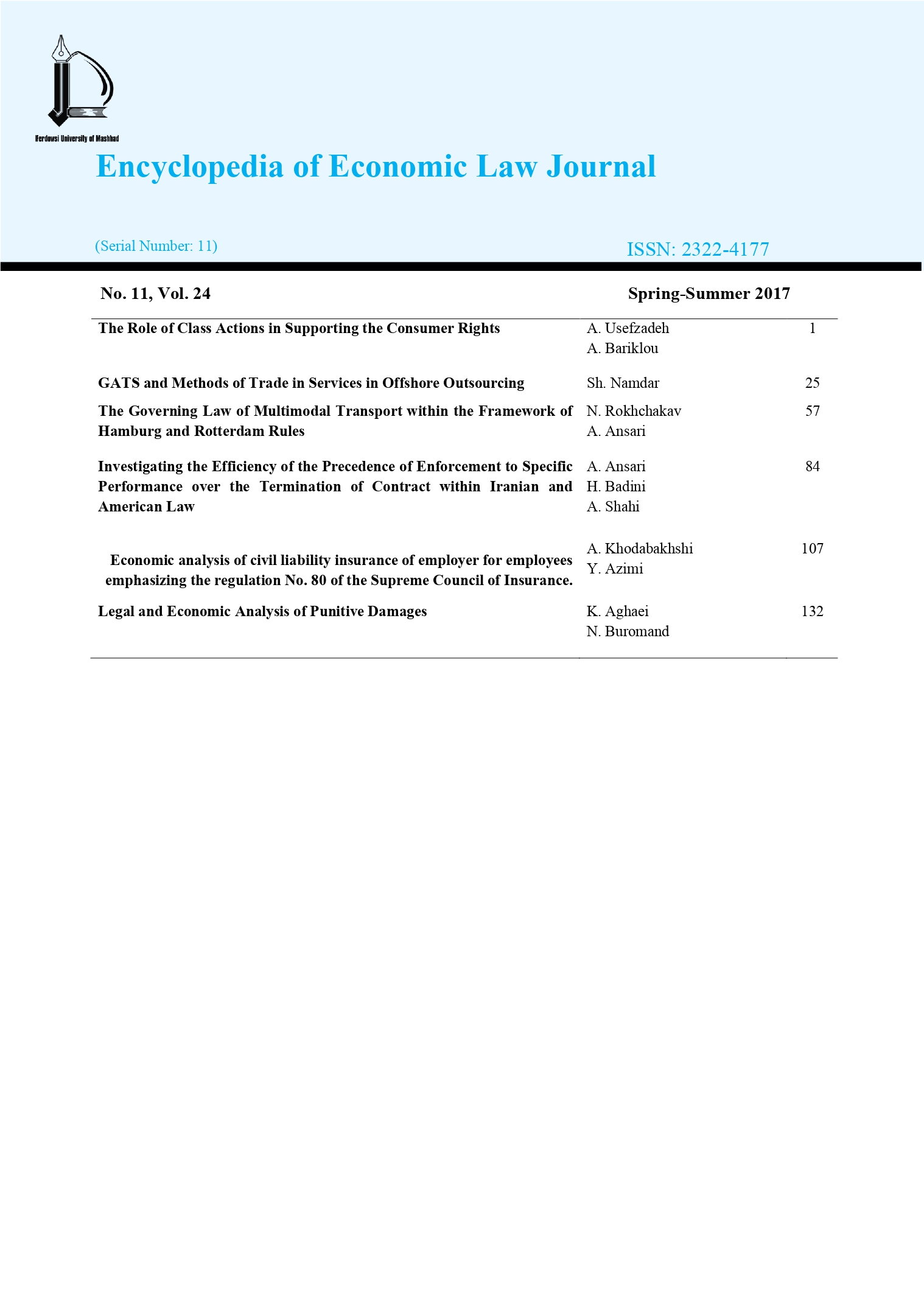Document Type : Scientific research
Authors
Ferdowsi University of Mashhad
Abstract
The use of containers as a means of moving cargo has rapidly increasing over the last decades and has given rise to the concept of multimodal transport. This mode of transport takes place by at least two different modes through one single contract from a place in one country where the goods are taken in charge by the carrier to a place designated for delivery situated in a different country. This way of transport has many advantages such as overcoming many of the technical problems as well as reducing loading and discharging time. While a new convention related to multimodal transport is expected but all efforts in this subject have failed for some reasons as unfortunately there is neither any uniform international law on multimodal contract nor is one expected in the near future. To solve this problem, some solutions have been proposed among which using network system for ascertaining the applicable law is one of the best possible options. The network system links existing sets of unimodal convention to the substantive rules. Under the network system, the multimodal transport agreement is divided into parts and the law applicable to each separate stage is determined as if it were a separate contract. So, all applicable unimodal international conventions are applied only to the related multimodal transport. It means that the convention on the contract for the international carriage of goods by road (CMR, 1956) on the road leg, the convention concerning international carriage by rail (COTIF, 1980) and its amendments (1999) on the rail stage, the convention for the unification of certain rules related to the international carriage by air (Warsaw Convention, 1929) and its amendments (1955), the convention for the unification of certain rules for international carriage by air (Montreal Convention, 1999) on the air leg, the Hague Rules as Amended by the Brussels Protocol (Hague-Visby Rules, 1968), the United Nations Convention on the Carriage of Goods by Sea (Hamburg Convention, 1978), and the United Nations Convention on Contracts for the international carriage of goods wholly or partly by the sea (Rotterdam Rules, 2009) on the sea leg will be applied.
Anyway, there is a considerable overlap between mandatory provisions of different unimodal conventions and the multimodal transport. These overlaps will lead to problems in governing law on multimodal transport. In order to solve this problem, sometimes theses conventions have created their own conflicts with the rules. The aim of this paper is to explore the possibilities of legal overlaps between the provisions of Hamburg Rules and Rotterdam Rules (as two international conventions related to the sea leg) in multimodal transport by relying on the descriptive-analytic research.
This essay shows Hamburg Rules contain a specific reference to multimodal carriage. In Article 1(6), the scope of application of convention is established concerning the situations where the carriage by sea is a part of a larger contract. Nevertheless, Hamburg rules don’t apply to the whole contract but are restricted to the international sea stage. Rotterdam Rules are intended to provide a modern uniform law which can regulate all international carriages of goods including an international sea leg, while the convention regulates parts of the wet multimodal transports. There are various possible situations in which more than one carriage may apply. Most of the potential conflicts resulting from the multimodal carriage are created by the multimodal articles in the unimodal carriage regimes which means that the articles extending the scope of the regimes beyond the type of carriage are primarily intended to regulate. Fortunately, some conventions contain rules that can solve some conflicts. In fact, they have conflicting rules. Following the overview of some conflicts among Hamburg Rules and Rotterdam Rules regulations, the essay shows that Article 25(5) of Hamburg Rules is conflicting with some other conventions such as Article 2 CMR and Article 3(1) COTIF convention which indicates that these rules should prioritize the Hamburg rules. In this regard, it is necessary to pay attention to Articles 26 and 82 of Rotterdam Rules. Although Article 26 of Rotterdam Rules does not prevent all possible conflicts with the international conventions on carriage other than by sea, it solves a lot of potential conflicts by incorporating the provisions on the carrier liability, the limitation of liability and time for the suit of other conventions. Article 82 deals with the relationship between Rotterdam Rules and other conventions regulating carriage by air, road, rail or inland water ways. According to Article 82 first paragraph, nothing in the Rotterdam Rules affects the application of any unimodal convention when the Rotterdam Rules enters in force regarding the liability of the carrier for the loss of or damage to the goods. Nevertheless, this general step-back rule is only applicable to the conflict with the international conventions on carriage of goods by air. In other cases the step-back rule is restricted to certain situations in Articles 82 (b) to (d).
Keywords


Send comment about this article